The University of Providence delivers online courses to students using the highly interactive Moodle platform.
Moodle is the world’s largest provider of this type of service, used by over 50,000 different institutions in roughly 200 countries.
This teaching model allows students to participate in class asynchronously each week of their course(s). This means that students do not need to be online at the same time. This is especially helpful to students who are working full time, raising a family, or campus students who can not fit a specific course into their schedule.
The Moodle model enables users to extend learning beyond the traditional classroom or other types of distance learning models. Collaboration between instructor and students is essential and builds a true learning community.
Moodle online courses are not independent study courses. They are completely interactive using any Internet ready computer with either Chrome or Firefox as preferred browsers. Additionally classes will have the availability of a virtual classroom component where the instructor and students can be interactive in real time. Both undergraduate and graduate courses may be available to the student online.
Log in to your Moodle account
PLEASE NOTE:
If you have a UP account and are logged into Office 365, you can click on this link to access a growing library of Student Online Help Resources and Tutorials on our University SharePoint site.
Frequently Asked Questions (FAQ)
What is my initial Moodle Username and password?
Your Moodle Username is provided by our administrative database in order to tie your MyArgoExpress enrollments to enrollments in Moodle.
Because of this, you will automatically be using Single Sign-On tied to your ArgoMail account login, so you don’t need a separate username and password—just click on the Single Sign-On link to connect to your Moodle courses.
It’s that easy!
When does my class meet?
The University of Providence uses two methods for communication between distant students and their professors. ASY sections rely entirely on Moodle, while other distance learning sections use Blackboard Collaborate Ultra. Moodle is an asynchronous (“not in real time”) course delivery method, and there are usually no set class times in asynchronous courses.
However, Collaborate Ultra provides live class meetings held in a virtual classroom on a scheduled day and time. Collaborate Ultra is a web browser-based app. It enables anyone to enjoy the full experience of an interactive online meeting, including sending and receiving voice/video, viewing and presenting shared content, and screen sharing.
Consequently, you should check the course schedule in ArgoExpress to confirm whether there are scheduled live class sessions required for any of your courses.
Remember that most Collaborate Ultra meetings are held at specific times. You will be accessing the meeting link(s) from within your corresponding Moodle class section.
*Please note that your upcoming courses will not “appear” on your Moodle Home page until seven (7) calendar days before the start of the new term.
What kind of computer do I need?
Most newer Internet-connected desktop or laptop computers (PCs or Macs) work fine with Moodle; however, Chromebooks are not recommended because they cannot run the full versions of Microsoft Office applications you will be using in your courses at UP.
Please note that Moodle performs best with recent versions of Chrome or Firefox browsers.
I'm enrolled in a course that requires live Collaborate Ultra class sessions. How do they work?
You do not need to log into Collaborate Ultra separately; you will join any scheduled online meetings from within your Moodle course, where your instructor will provide a link.
The recommended Web browser for the best Collaborate Ultra experience is Chrome, but recent versions of Firefox will also work.
Click to visit the Blackboard Collaborate Ultra site for helpful information on how to get started participating in your Collaborate Ultra course meetings.
Here’s an online video introducing the Collaborate Ultra interface:
https://youtu.be/6SKSODqUeWg
I have to miss one of my live class sessions. Is there a way to “make up” the class?
If you just can’t make it to your class, log into the Moodle portion of your course, and click on the Collaborate link. Rather than joining the live session, click the Session Menu button in the upper left-hand corner to reveal a link to access each week’s Collaborate recordings. Because the recordings are listed by date, it helps to know which week of the semester you may have missed class.
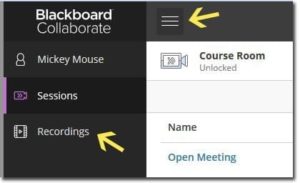
You can view the recording right in your browser. Some courses also allow you to Download and Save the recording of a session to your local device. After you have saved the file to your computer, you can watch it using VLC (recommended) or another media player.
PLEASE NOTE: If you access the Recordings page and don’t find any “Recent Recordings,” select the Filter menu option in the upper right-hand corner to view recordings by date range, and you should be able to find previous weeks’ recordings.
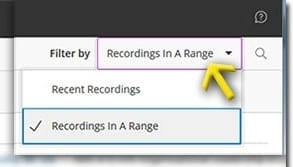
I was right at the end of typing in a very long post in Moodle and just got informed I'd lost my connection, and all my work was gone.
Like most Web applications, Moodle has a built-in “time-out” for inactivity.
This means that if you don’t click on a link to load a new page within that two-hour limit, Moodle assumes you’ve walked away from the computer and will drop the connection to protect your privacy. Unfortunately, typing on the keyboard does not count in Web applications the same as clicking on a link.
To avoid this problem, if you think you’ll take longer than two hours to compose a post, it’s safest to type it “offline” (polishing it in Microsoft Word) and then copy and paste it into the Moodle forum composition window when you’re ready to submit your posting.
I’m in a Moodle class and just encountered problems taking a test. For some reason, now I can't finish the exam. Is there something else I need to do?
Depending on how stable your connection to the Internet is, and which browser version you use, you may encounter problems with longer exams on Moodle.
For example, if you take several hours to research and submit your answers, the connection to the Moodle server might be dropped for “inactivity” even though you working on the test. The way Internet connections work, simply clicking or typing in answers doesn’t qualify as “activity” unless you are periodically saving your work or moving on to another page of questions. If this should happen to you, you’ll need to get your instructor to reset your attempt before you can restart the exam.
PLEASE NOTE: It is also a very good idea to take online exams only from a stable (preferably wired rather than wireless) connection to the Internet. We have heard of students who tried to take exams from their smartphones—some while riding in a car on a road trip. Think of how often a cellular call can get dropped, and you can easily imagine the rest of the story….
Learn from those mistakes, find yourself a stable connection in a quiet space free from interruptions, and your online exams should go well!
I don’t live in Montana. When do I attend my classes?
Montana is in the Mountain Time Zone. We observe the same Daylight savings rules as (most of) the rest of the nation.
That puts us two hours “earlier” than New York, one hour “later” than the West Coast, and seven hours earlier than Greenwich Mean Time. Please allow for differences in time zones when you plan your semester enrollment.
Here’s a map of North American time zones relative to Mountain Time to provide a reference.
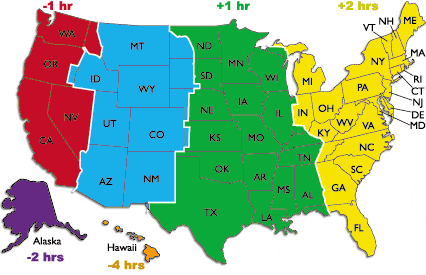
I'm having trouble finding something from a previous week in my Moodle course. Is there an easier way than clicking every single week?
If you need to find something in a course, rather than scrolling and scrolling (as in the old version), you can take advantage of a new “Search” tool in the Navigation block at the top of your course. Click on the search icon:
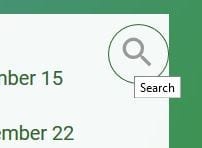
Type in part of the name of the item you need to find. Moodle will bring up matches to that keyword search as you type:
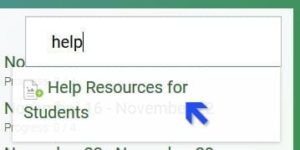
Click on the suggested result, and Moodle will take you right to that item wherever it is found in the course:
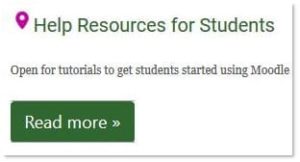
Pro Tip: Every Moodle course has help resources for students available by following these steps.
I want to apply some formatting to a forum post, but I don't know how.
Start by turning on the Advanced editing tools before you begin typing your post.
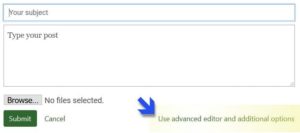
This will activate a toolbar with two levels of formatting buttons (the second one hidden until you click the “show/hide” button), which allow you to add bold, italics, font color, web links, align or indent text, etc.

I'm trying to upload a file into Moodle, but it is too large. How can I get around this?
Because our Moodle server provides over 400 courses each term, each course has a limit on the size of files that can be uploaded to it. Larger files (such as video clips or PowerPoints with embedded audio) will not upload correctly. You will need to find another way to submit your assignment, but if the file is too large to upload into Moodle, it is probably too large to send as an e-mail attachment as well.
Fortunately, this is fairly easy to work around. All students have an ArgoMail e-mail account, and accessing that through Office 365/Outlook also gives you access to 1 TB (terabyte) of Microsoft OneDrive cloud storage. Simply click on the applications icon in the upper left-hand corner to find the link to your OneDrive cloud storage, which you may need to initialize the first time you access it:
(scroll for more)
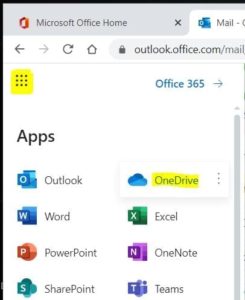
If you do not already have a folder called “Shared with Everyone” in your OneDrive Documents storage, you should create one first and make sure the sharing is set to “Everyone” with view only access.
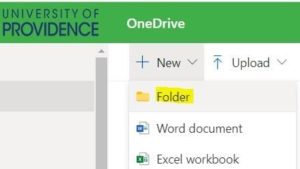
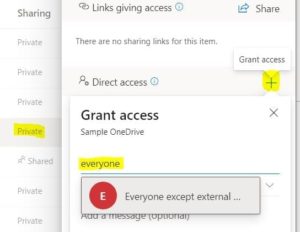
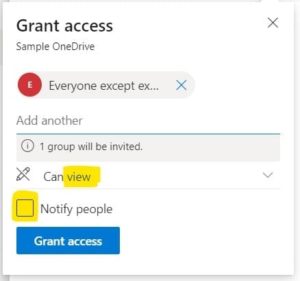
Notice that we unchecked the option to notify people before granting access.
Once the shared access is set, click to enter that shared folder, and upload your large file there:
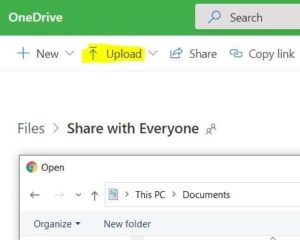
When the file is finished uploading, hover over its name and click the “three dots” to select “Copy link.” This will bring up a dialog box creating the URL (web address) that points directly to your large file in your OneDrive shared folder.
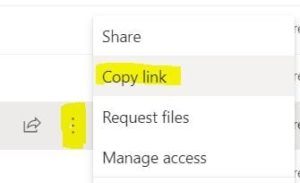
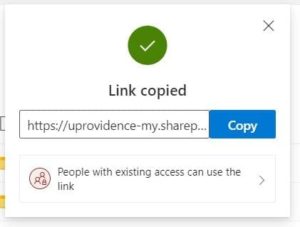
This will be the link you can paste into a Word document that you can upload as an assignment submission within Moodle. Because this will be a one-page document, it will easily upload into Moodle. (This is only necessary if you are supposed to upload an assignment. If you are supposed to post to a discussion forum, simply paste the URL (web address) into the forum text editing box.)
Pro tip: When accessing OneDrive links to very large files with embedded audio, you may see messages indicating the audio cannot be played because it exceeds size limitations. You can click on the “. . .” menu link above the file in OneDrive to select the Download option in order to save the file to your local PC, where you can then open the file (e.g. in PowerPoint) and play the audio fine.

